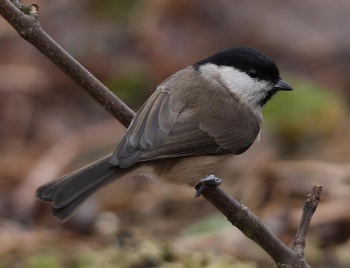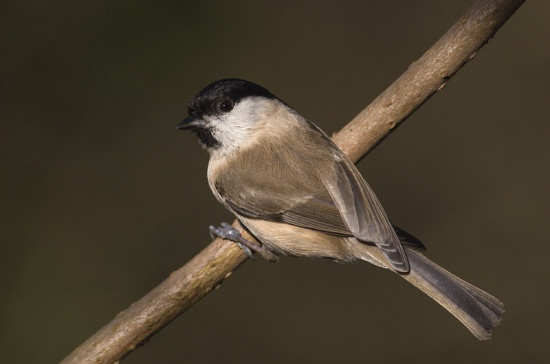m |
(Photo caption. Distribution started. References updated. GSearch amended to account for both scientific names. Video Link) |
||
| (4 intermediate revisions by 2 users not shown) | |||
| Line 1: | Line 1: | ||
| − | + | [[Image:Marsh-tit-jan-12-2008-1.jpg|thumb|550px|right|Photo by {{user|Adey+Baker|Adey Baker}}<br/ > Burbage Wood, [[Leicestershire]], [[UK]].]] | |
| − | + | ;[[:Category:Poecile|Poecile]] palustris<br /> | |
| − | + | ''Parus palustris'' | |
| − | [[Image:Marsh-tit-jan-12-2008-1.jpg|thumb|550px|right|Photo by Adey Baker<br/ > | + | |
==Identification== | ==Identification== | ||
Large shiny black cap, small black bib. grey brown upperparts, dull buff underneath. Often has pale spot on upper mandible at base of bill as opposed to just pale edges as seen on Willow Tit. Cheek may have clear 'rusty looking' demarkation nearing the nape. Usually neat and dapper looking as opposed to the scruffy looking Willow Tit. | Large shiny black cap, small black bib. grey brown upperparts, dull buff underneath. Often has pale spot on upper mandible at base of bill as opposed to just pale edges as seen on Willow Tit. Cheek may have clear 'rusty looking' demarkation nearing the nape. Usually neat and dapper looking as opposed to the scruffy looking Willow Tit. | ||
| + | [[Image:Marsh_Tit_Redhouse.jpg|thumb|350px|right|showing colour change to cheek patch and pale spot on upper mandible<br/>Photo by {{user|James+Thomas|James Thomas}}<br/>Redhouse, North Yorkshire 22 Jan 2011]] | ||
====Similar Species==== | ====Similar Species==== | ||
Very similar to [[Willow Tit]]. | Very similar to [[Willow Tit]]. | ||
| − | + | ||
==Distribution== | ==Distribution== | ||
| + | [[Europe]] and [[Asia]]: | ||
==Taxonomy== | ==Taxonomy== | ||
Until recently, all Tit species were believed to belong to the same genus, ''Parus''. Since then, research results appeared which made it more likely that the correct treatment was to divide the Tit/Chickadee species into several genera; Marsh Tit thereby became a member of the genus ''Poecile''. [[Black-bibbed Marsh Tit]] (''Poecile hypermelaena'') is a recent split from the regular Marsh Tit. | Until recently, all Tit species were believed to belong to the same genus, ''Parus''. Since then, research results appeared which made it more likely that the correct treatment was to divide the Tit/Chickadee species into several genera; Marsh Tit thereby became a member of the genus ''Poecile''. [[Black-bibbed Marsh Tit]] (''Poecile hypermelaena'') is a recent split from the regular Marsh Tit. | ||
| + | ====Subspecies==== | ||
| + | [[Image:Marsh Tit Flight.jpg|thumb|350px|right|Photo by {{user|Digiscoper321|Digiscoper321}}<br />West [[Sweden]], February 2012]] | ||
| + | There are 8 subspecies<sup>[[#References|[1]]]</sup>: | ||
| + | *''P. p. palustris'': | ||
| + | :*[[British Isles]], southern [[Scandinavia]] and central [[Europe]] to Pyrenes and the [[Balkans]] | ||
| + | *''P. p. stagnatilis'': | ||
| + | :*Western [[Russia]] to northern [[Turkey]], eastern [[Yugoslavia]] and [[Bulgaria]] | ||
| + | *''P. p. kabardensis'': | ||
| + | :*Caucasus Mountains | ||
| + | *''P. p. italicus'': | ||
| + | :*[[France|French Alps]] and [[Italy]] | ||
| + | *''P. p. brevirostris'': | ||
| + | :*[[Siberia]] to [[Mongolia]], north-eastern [[China]] and [[Korea]] | ||
| + | *''P. p. ernsti'': | ||
| + | :*Sakhalin | ||
| + | *''P. p. hensoni'': | ||
| + | :*Northern [[Japan]] (southern Kuril Islands and Hokkaido) | ||
| + | *''P. p. hellmayri'': | ||
| + | :*Southern and eastern [[China]] (Sichuan to Liaoning) and southern [[Korea]] | ||
==Habitat== | ==Habitat== | ||
Prefers deciduous woodland. | Prefers deciduous woodland. | ||
==Behaviour== | ==Behaviour== | ||
| − | Moss and grass cup in existing hole either in tree or wall. It eats mainly insects in summer, seeds and berries in autumn and winter. Will use feeders. | + | ====Breeding==== |
| + | Moss and grass cup in existing hole either in tree or wall. | ||
| + | ====Diet==== | ||
| + | It eats mainly insects in summer, seeds and berries in autumn and winter. Will use feeders. | ||
| + | ====Vocalisation==== | ||
| + | Its voice is a most distinctive sneezing sound. | ||
| + | ==References== | ||
| + | #{{Ref-Clements6thOct12}} | ||
| + | {{ref}} | ||
| + | ==External Links== | ||
| + | {{GSearch|Tit+palustris}} | ||
| + | <br /> | ||
| + | {{Video|Marsh_Tit}} | ||
| − | + | [[Category:Birds]][[Category:Poecile]] [[Category:Videos]] | |
| − | |||
| − | |||
| − | [[Category:Birds]][[Category:Poecile]] | ||
Revision as of 20:58, 19 November 2012
- Poecile palustris
Parus palustris
Identification
Large shiny black cap, small black bib. grey brown upperparts, dull buff underneath. Often has pale spot on upper mandible at base of bill as opposed to just pale edges as seen on Willow Tit. Cheek may have clear 'rusty looking' demarkation nearing the nape. Usually neat and dapper looking as opposed to the scruffy looking Willow Tit.

Photo by James Thomas
Redhouse, North Yorkshire 22 Jan 2011
Similar Species
Very similar to Willow Tit.
Distribution
Taxonomy
Until recently, all Tit species were believed to belong to the same genus, Parus. Since then, research results appeared which made it more likely that the correct treatment was to divide the Tit/Chickadee species into several genera; Marsh Tit thereby became a member of the genus Poecile. Black-bibbed Marsh Tit (Poecile hypermelaena) is a recent split from the regular Marsh Tit.
Subspecies
There are 8 subspecies[1]:
- P. p. palustris:
- British Isles, southern Scandinavia and central Europe to Pyrenes and the Balkans
- P. p. stagnatilis:
- Western Russia to northern Turkey, eastern Yugoslavia and Bulgaria
- P. p. kabardensis:
- Caucasus Mountains
- P. p. italicus:
- French Alps and Italy
- P. p. brevirostris:
- P. p. ernsti:
- Sakhalin
- P. p. hensoni:
- Northern Japan (southern Kuril Islands and Hokkaido)
- P. p. hellmayri:
Habitat
Prefers deciduous woodland.
Behaviour
Breeding
Moss and grass cup in existing hole either in tree or wall.
Diet
It eats mainly insects in summer, seeds and berries in autumn and winter. Will use feeders.
Vocalisation
Its voice is a most distinctive sneezing sound.
References
- Clements, J. F., T. S. Schulenberg, M. J. Iliff, B.L. Sullivan, C. L. Wood, and D. Roberson. 2012. The eBird/Clements Checklist of Birds of the World. 6th ed., with updates to October 2012. Ithaca: Cornell Univ. Press. ISBN 978-0801445019. Spreadsheet available at http://www.birds.cornell.edu/clementschecklist/downloadable-clements-checklist
Recommended Citation
- BirdForum Opus contributors. (2024) Marsh Tit. In: BirdForum, the forum for wild birds and birding. Retrieved 23 April 2024 from https://www.birdforum.net/opus/Marsh_Tit
External Links





